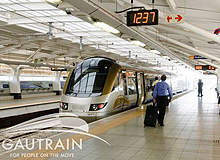
From relieving a congested central American country to revitalising public transport and business in Africa to potentially providing the link to a pan-Asian, and potentially Asia to Europe rail route, there’s no doubt that some highly ambitious railroad projects are in development.
South Africa: Gauteng’s Gautrain
On 8 June 2010 the second phase of the Gautrain System in South Africa opened for commercial service. It had already recorded one million passengers within the first hundred days of the start of phase one, showing right from the start how beneficial it would be to the province and South Africa as a whole.
The Gautrain, capable of travelling at 160km per hour, provides an 80km rail link between Pretoria and Johannesburg and between OR Tambo International Airport and Sandton, will connect ten stations (three of which are located underground) and three metropolitan areas once it is completed.
The Gautrain rail link has already improved the perception of public transport in South Africa, but it will also provide new impetus for the already bustling central business districts of Johannesburg and Pretoria. The railway will also reduce road congestion – aiming to cut the number of cars on the N1 Highway by 20%.
It is also bringing the promise of a more sustainable future to communities. “Many lives are changing for the better as people are learning new skills, interacting with global cultures, finding new investment opportunities and working with ground-breaking international technology that is unique to this project,” says Gautrain spokesperson, Dr. Barbara Jensen.
With a predicted total cost of $3.6bn (25.5bn Rand), the Gautrain has been financed via a public-private-partnership (PPP) structure, with the Gauteng provincial government as the public partner and the Bombela Concession Company (which originally consisted of Murray & Roberts, Bouygues, Bombardier and SPG with ABSA and J&J joining later) as the private partner.
How well do you really know your competitors?
Access the most comprehensive Company Profiles on the market, powered by GlobalData. Save hours of research. Gain competitive edge.

Thank you!
Your download email will arrive shortly
Not ready to buy yet? Download a free sample
We are confident about the unique quality of our Company Profiles. However, we want you to make the most beneficial decision for your business, so we offer a free sample that you can download by submitting the below form
By GlobalDataThe rolling stock comprises 96 of Bombardier’s Electrostar rail cars, which are able to transport over 100,000 passengers each day. While gradients of 1.5% are typical, the stock has been customised for the Gautrain link so that the conditions imposed by the track network can be met – as gradients of 4% have to be negotiated.
It is anticipated that the Gautrain will commence its operations on the entire system towards the middle of 2011.
Cambodia’s pan-Asia link
The first section of a new international standard railroad officially opened in Cambodia last year – a major step in the development of a long-awaited pan-Asian railroad. This Cambodia section of the railroad is approximately 650km, linking Cambodia’s border with Thailand to the country’s main seaport of Sihanoukville via the capital city of Phnom Penh.
“The railway was privatised in 2009 as a precondition of ADB financing and ADB has provided $84m in financing towards the $141m project,” explains ADB’s Senior Transport Economist for Southeast Asia Peter Broch. Other financiers include the Australian government ($21.5m), the OPEC Fund for International Development ($13m) and the Government of Malaysia ($2.8m grant in aid).
Cambodia’s railways have been in bad condition for decades due to conflicts in the country, meaning rail traffic has declined considerably. In some areas it is so bad that homemade ‘lorries’ – bamboo platforms powered by water-pump motors – provide the main form of rail transport.
This new railroad will improve economic activity substantially and will mainly be used to improve freight transport. “The railway will primarily be used for freight traffic, especially between Phnom Penh and Sihanoukville Port, as well as between Phnom Penh and Thailand via the border crossing at Poipet and Aranyaprathet,” says Broch. “Once the Cambodian railway is completed, sub-regional rail traffic between Singapore and other Southeast Asian neighbors, namely Thailand and Malaysia, will be possible.”
Other benefits include a reduction of heavy truck traffic on the country’s primary highways – NR4 to Sihanoukville and NR5 to Poipet (according to Broch the opening of the first section has already reduced traffic on the NR4 by about 220 trucks a week). Other advantages include an increase in competition of freight traffic (a reduction in rates of around 30% is expected) and the significant increase in speed of overland freight movements – 24 hours overland versus seven to ten days by ship via Singapore.
Once this railroad is finished there is only one remaining section, between Phnom Penh and Ho Chi Minh City, Vietnam, that will need to be completed before a pan-Asian railway is complete. “The final link in the pan-Asian route will likely run from Phnom Penh to Kampongcham, Cambodia, and then into Vietnam at Loc Ninh, and onwards to Ho Chi Minh City,” says Broch. “The complete Singapore-to-Scotland railway route could be ready shortly after 2015 – it would stretch over 10,000km”
Panama – metro plans to ease congestion
In Panama in Central America, plans are underway to develop a 13.7km-long underground line that is valued at a cost of approximately $1.5bn, including the civil engineering and rolling stock costs. The construction company FCC, in consortium with Brazilian construction company Odebrecht and rolling stock provider Alstom were awarded the contact from the SMP (Secretaría del Metro de Panama) to build the first line of the Panama Metro.
With approximately 1.2 million people, Panama City is considered to be the most modern and commercially-focused city in the region. However, having experienced considerable congestion problems, the underground line will help to alleviate the transport issues in the city.
According to Alstom, 7.2km of the line will be underground and 6.5km on viaduct with 13 stations. It will run from Los Andes at the north of the city, through the historical downtown (Plaza 5 de Mayo), the financial centre (Vía España), and will end at the Albrook neighbourhood, where the maintenance and workshop centre will be located.
Alstom will be implementing its Urbalis CBTC solution for its train control system. This is a tried and tested modern radio-based system, deployed all around the world as a result of its high capacity and driverless metros in major cities such as Beijing and Toronto.
Construction work on the new metro is expected to be completed by the end of 2013. In its initial phase, the metro line will have capacity for 15,000 people per hour each way, but is expected to increase to 40,000 by 2035.





